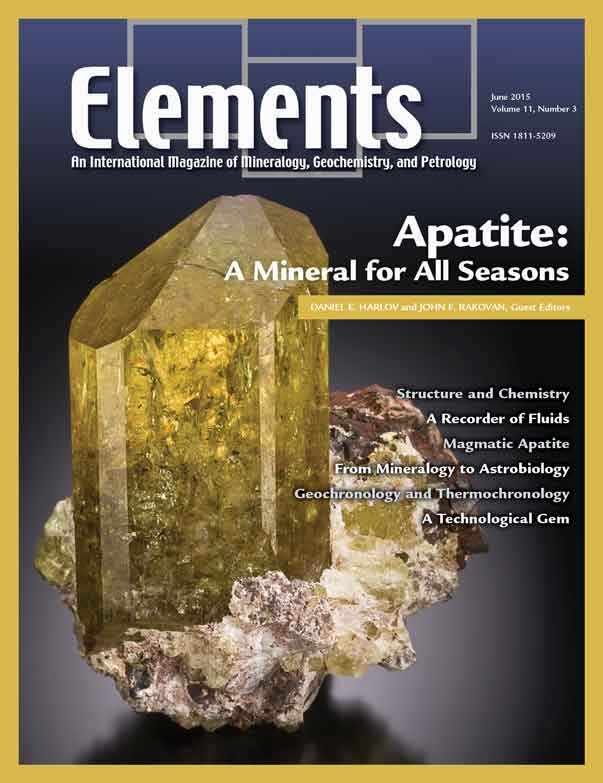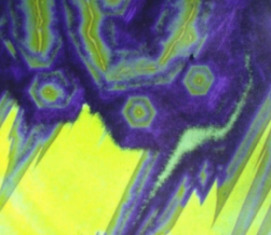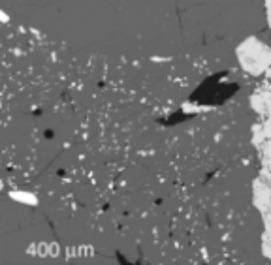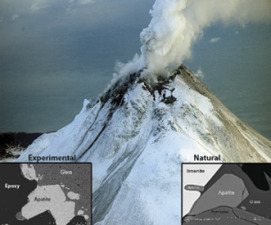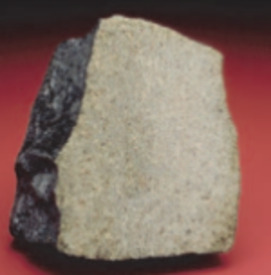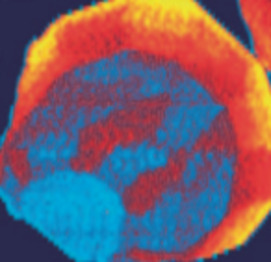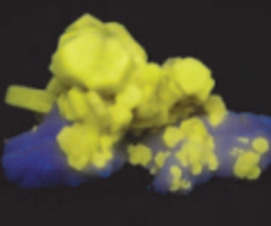
Apatite: A Mineral for All Seasons
Daniel E. Harlov and John F. Rakovan – Guest Editors
Table of Contents
At the intersection of the biological, geological, and materials science realms, the topic of apatite is highly diverse and interdisciplinary. Apatite-group minerals are the dominant phosphates in the geosphere and biosphere. They are found in virtually all rock types as the principal sink for phosphorus and fluorine, and in many cases yttrium and the rare earth elements. They form the major mineral component in verte- brate bones and are the base of the global phosphorus cycle. The isotope chemistry of U, Th, and Pb in apatite has led to their broad application in geochronology. Last, the physical and chemical properties of apatite- group minerals make them ideal for many technological applications, including phosphors, lasers, prosthetics, ceramics, metal sequestration agents, and potential solid nuclear waste forms. This issue of Elements presents cutting-edge research on apatite with regard to (1) geochemical investigations on crustal and mantle processes on Earth, (2) biological processes, (3) practical applications in industry, and (4) geochemical processes in extraterrestrial environments.
Structurally Robust, Chemically Diverse: Apatite and Apatite Supergroup Minerals
Apatite: A Fingerprint for Metasomatic Processes
Magmatic Apatite: A Powerful, Yet Deceptive, Mineral
Extraterrestrial Apatite: Planetary Geochemistry to Astrobiology
Geochronology and Thermochronology Using Apatite: Time and Temperature, Lower Crust to Surface
A Technological Gem: Materials, Medical, and Environmental Mineralogy of Apatite
AHF Analysentechnik
Analytical Instrument Systems, Inc.
Australian Scientific Instruments (ASI)
Bruker Nano
Cambridge University Press
Cameca
Excalibur Mineral Corporation
Geochemist’s Workbench
JEOL
ProtoXRD
Rocks & Minerals
Savillex
Wiley
Zeiss
v11n4 Societal and Economic Impacts of Geochemistry
Guest editor: John Ludden, Francis Albarède (École Nationale Supérieure, Lyon), and Max Coleman (Jet Propulsion Laboratory, Caltech)
As geochemists and mineralogists, we are well aware of the impact of our science and when pushed we can often reel out great examples where our discoveries have influenced industry and the social well- being on the planet. However, this sort of drum-beating is not intuitive, and the explicit need to demonstrate impact in our science is, in many nations, being used as a measure of the required funding level for our discipline. The papers in this issue will show how we use geochemistry to achieve impact, and they will provide the basic science coupled to case studies from the hydrocarbon, mineral, environmental, and health and nutrition fields. The authors will document economic estimates of the benefits of their science; an example is the role of mass spectrometry in the oil and gas sector, in disease control, and in the use of isotopic tracers in mineral exploration.
- The Impact of Geochemistry By John Ludden, Francis Albarède, and Max Coleman
- Applied Geochemistry in Mineral Exploration and Mining Kurt Kyser (Queen’s University), John Barr, and Christian Ihlenfeld
- Environmental Mineralogy: New Challenges, New Materials Georges Calas (UPMC, Paris), Paul F. McMillan (UCL, London), and Rizlan Bernier-Latmani (EPFL, Lausanne)
- Geochemically Based Solutions for Urban Society: London, A Case Study John Ludden (British Geological Survey), Denis Peach, and Dee Flight
- Stable Isotopes Trace the Truth: From Adulterated Foods to Crime Scenes James Ehleringer (University of Utah), Lesley A. Chesson, Luciano O. Valenzuela, Brett J. Tipple, and Luiz A. Martinelli
- Metal Stable Isotopes in the Human Body: A Tribute of Geochemistry to Medicine Francis Albarède (Université de Lyon)
- Mineralogy of Mars (February 2015)
- Arc Magmatic Tempos (April 2015)
- Apatite (June 2015)
- Societal and Economic Impacts of Geochemistry (August 2015)
- Supergene Metal Deposits (October 2015)
- Geomicrobiology and Microbial Geochemistry (December 2015)
Download 2015 Thematic Preview


